One of the first spring-flowerers, the wild Sagewood (Buddleja salviifolia) produces a profusion of nectar-laden blossoms. Their pungent yet strangely sweet scent attracts many insects.
There are seven species of the Buddleja or Wild-elder family in South Africa. The Buddleja salviifolia is so named as its leaves resemble salvia or sage. It is often shrubby in shape, but can also be a small tree up to eight metres tall, and its hard wood has been used to make spear shafts and fishing rods.
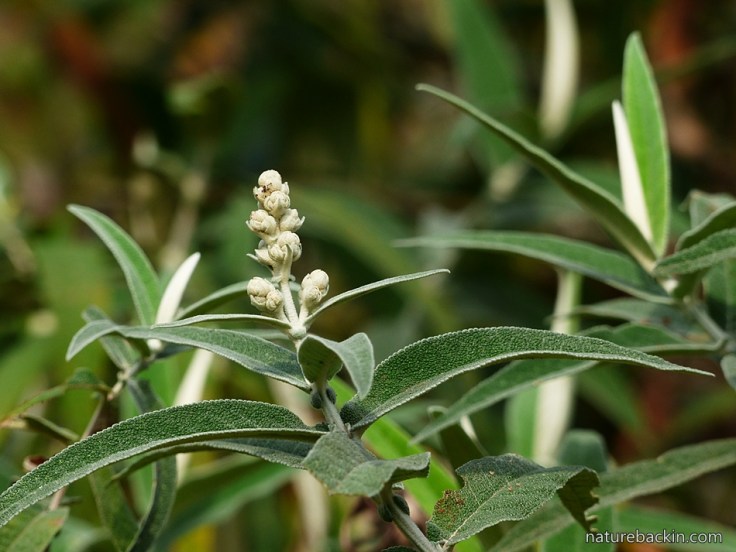
Most of the buds on our Buddleja salviifolia plants our still tightly furled, but on the plant with lilac-coloured flowers, a few flowerheads are already in bloom, with one of them hosting the Flower Mantis that was featured in last week’s post
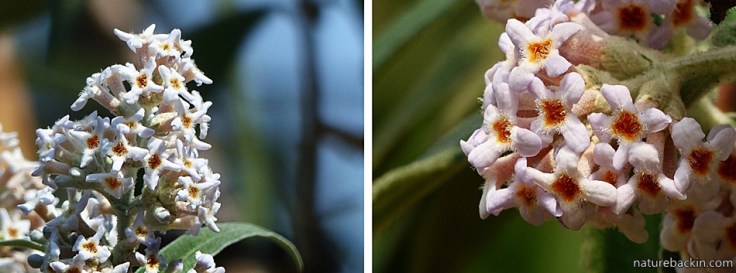
Several of the Buddleja salviifolia plants in our garden have creamy white flowers. The one in the photo above-left was photographed last year. The plant with lilac-coloured flowers, which hosts the Flower Mantis, I photographed yesterday
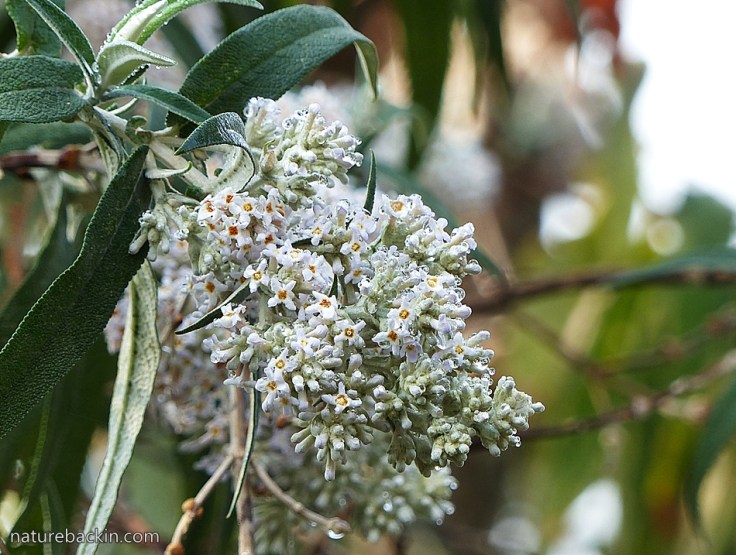
Also photographed in spring last year is this flowerhead, drooping under the weight of raindrops from the previous night’s rain

In a flowerhead neighbouring that of the Flower Mantis I spotted this hoverfly. Rather than hovering, it was moving from flower to flower, methodically eating nectar or pollen from the centre of each blossom
The Sagewood attracts many pollinators including several species of fly. I worked out that the hoverfly in the photo above is one of the syrphid species of hoverfly, but I was not able to be more specific than that. Hoverflies are important pollinators, and their larvae may be decomposers feeding on dead organic matter with the larvae of other species feeding on aphids; both activities are beneficial to garden plants. It is therefore in the interest of gardeners to encourage hoverflies by enabling them to breed successfully.
How to do that is explained on the Biodiversity Explorer website. Suitable places for hoverfly egg-laying include ponds with dense aquatic or bank vegetation, compost heaps, and areas where plants and grasses are left to grow undisturbed. Active mowing and hacking destroy habitats suitable for egg-laying, and clearly the use of insecticides should be avoided. Unfortunately, traditional gardening methods are not friendly to garden-friendly hoverfly larvae. Biodiversity Explorer suggests that a “little ‘wilderness’ in a hind corner of the garden” may serve as a refuge enabling hoverfly larvae to survive. For more on enabling secret or wilderness sections of the garden see my earlier posts The understorey: The tale of the white starred robin and Live and let live gardening.

To show the small size of the flowers of the Sagewood (Buddleja salviifolia) I placed three individual flowers next to two matchsticks. As a follow-up to last week’s post on the Flower Mantis this comparison might be helpful in gauging just how small the Flower Mantis is
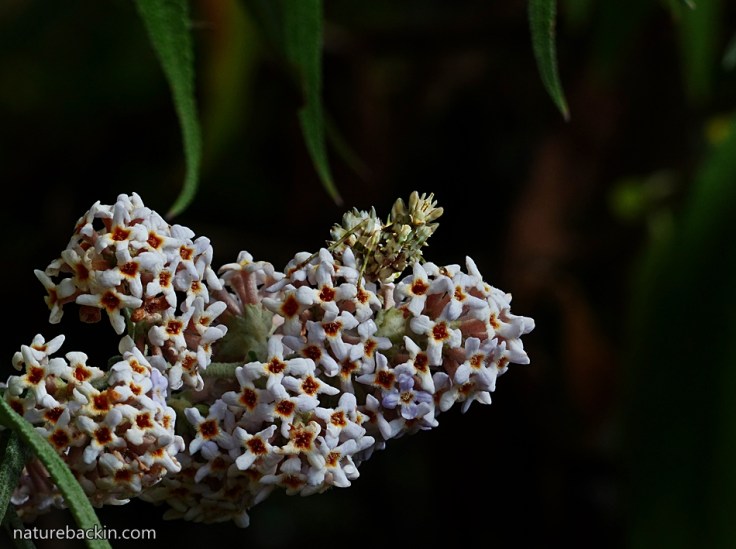
In the above photo the immature Flower Mantis is sitting atop its Sagewood flowerhead, holding its forelegs folded in front of it, with the ornate top of its curled-up abdomen just visible behind. It is only when an adult that the Mantis develops wings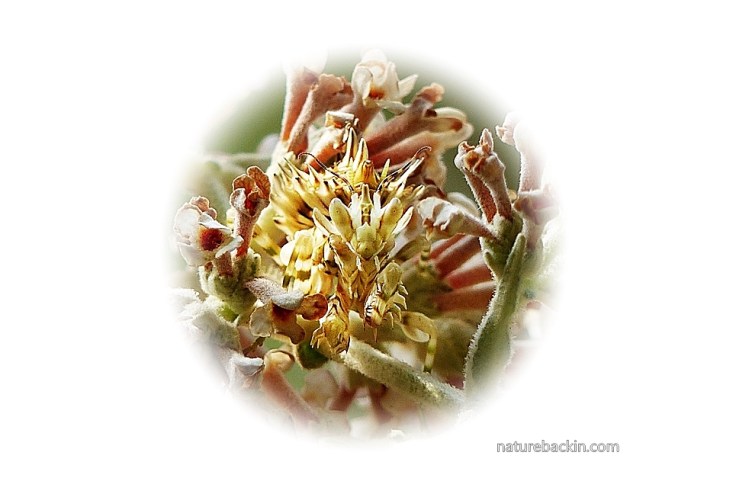 The particular Sagewood flowerhead on which the Flower Mantis is residing is starting to dry and shrivel slightly, perhaps making it easier to see the fantastically elaborate form of the Mantis. At this stage of their lives, mantises moult their exoskeleton every few weeks. I wonder if I will be fortunate enough to witness one of these metamorphoses
The particular Sagewood flowerhead on which the Flower Mantis is residing is starting to dry and shrivel slightly, perhaps making it easier to see the fantastically elaborate form of the Mantis. At this stage of their lives, mantises moult their exoskeleton every few weeks. I wonder if I will be fortunate enough to witness one of these metamorphoses
Sources: Barkemeyer, Werner. [n.d.]. Family: Syrphidae (hoverflies). Biodiversity Explorer. http://www.biodiversityexplorer.org/flies/syrphidae/index.htm; Boon, Richard. 2010 (2nd ed.). Pooley’s Trees of Eastern South Africa. Durban: Flora & Fauna.
Posted by Carol









August 21, 2018 at 3:02 am
We’ve been attempting to make our yard more friendly for wildlife, including hoverflies. Unfortunately some of our biggest challenges. so far, have been to discourage quite a few invasive species that seem to take over and crowd out the natives. The Buddleja (though very lovely) is one of those. It has taken over and spread all along our highways here. It seems as though introduced plants from different environments either don’t do well at all, or far TOO well when planted outside their native range. Wish it weren’t so.
LikeLiked by 1 person
August 23, 2018 at 8:23 pm
Is that one of the South African Buddleja’s that is invasive in your part of the world I wonder?
LikeLike
August 17, 2018 at 9:51 am
It’s amazing just how beautiful and interesting flowers can be in closeup.
LikeLiked by 1 person
August 18, 2018 at 3:43 pm
I think so too – even the seemingly simplest flower becomes incredibly complex.
LikeLike
August 17, 2018 at 4:39 am
Interesting stuff and I too liked the matchsticks comparison. Really shows the scale.
LikeLiked by 1 person
August 18, 2018 at 3:39 pm
Luckily matchsticks are universally the same size 🙂
LikeLiked by 1 person
August 20, 2018 at 3:07 am
Unless they’re those big ones used for lighting barbecues. Then that would be a fearsome mantis!
LikeLiked by 1 person
August 23, 2018 at 8:21 pm
🙂
LikeLike
August 16, 2018 at 9:08 pm
Gorgeous pics as usual, Carol.
It is a Migrant Hoverfly.
LikeLiked by 1 person
August 18, 2018 at 2:50 pm
Thanks Ark. So many of the hoverflies have very similar markings, and there is the complication of introduced species alongside the native species.
LikeLike
August 16, 2018 at 8:47 pm
That mantis looks like something in a sci-fi film. The matchsticks made me realize how tiny these flowers really are!
LikeLike
August 16, 2018 at 7:51 pm
Gosh. Spring has sprung. Things are definitely getting moving in that garden of yours. Fascinating post.
LikeLiked by 1 person
August 18, 2018 at 2:48 pm
And we have had rain 🙂 Lovely to see your summery post on meadow flowers today as along with the rain we have had a huge dip in temperature and it is very wintery indeed.
LikeLiked by 1 person
August 18, 2018 at 2:59 pm
We’ve had such an unusually long hot summer I can’t remember winter, for once in my life.
LikeLiked by 1 person
August 16, 2018 at 7:36 pm
Such an interesting read!
LikeLiked by 1 person
August 18, 2018 at 2:45 pm
Thank you Anne. The Buddleja has led me off on so many unexpected tangents!
LikeLike
August 16, 2018 at 6:14 pm
Exquisite photos!
LikeLiked by 1 person
August 18, 2018 at 2:43 pm
Thank you for your kind comment 🙂
LikeLiked by 1 person